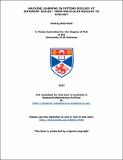Files in this item
Machine learning in systems biology at different scales : from molecular biology to ecology
Item metadata
| dc.contributor.advisor | Smith, Victoria Anne | |
| dc.contributor.advisor | Husmeier, Dirk | |
| dc.contributor.author | Aderhold, Andrej | |
| dc.coverage.spatial | 195 | en_US |
| dc.date.accessioned | 2015-07-27T09:31:22Z | |
| dc.date.available | 2015-07-27T09:31:22Z | |
| dc.date.issued | 2015 | |
| dc.identifier.uri | https://hdl.handle.net/10023/7030 | |
| dc.description.abstract | Machine learning has been a source for continuous methodological advances in the field of computational learning from data. Systems biology has profited in various ways from machine learning techniques but in particular from network inference, i.e. the learning of interactions given observed quantities of the involved components or data that stem from interventional experiments. Originally this domain of system biology was confined to the inference of gene regulation networks but recently expanded to other levels of organization of biological and ecological systems. Especially the application to species interaction networks in a varying environment is of mounting importance in order to improve our understanding of the dynamics of species extinctions, invasions, and population behaviour in general. The aim of this thesis is to demonstrate an extensive study of various state-of-art machine learning techniques applied to a genetic regulation system in plants and to expand and modify some of these methods to infer species interaction networks in an ecological setting. The first study attempts to improve the knowledge about circadian regulation in the plant Arabidopsis thaliana from the view point of machine learning and gives suggestions on what methods are best suited for inference, how the data should be processed and modelled mathematically, and what quality of network learning can be expected by doing so. To achieve this, I generate a rich and realistic synthetic data set that is used for various studies under consideration of different effects and method setups. The best method and setup is applied to real transcriptional data, which leads to a new hypothesis about the circadian clock network structure. The ecological study is focused on the development of two novel inference methods that exploit a common principle from transcriptional time-series, which states that expression profiles over time can be temporally heterogeneous. A corresponding concept in a spatial domain of 2 dimensions is that species interaction dynamics can be spatially heterogeneous, i.e. can change in space dependent on the environment and other factors. I will demonstrate the expansion from the 1-dimensional time domain to the 2-dimensional spatial domain, introduce two distinct space segmentation schemes, and consider species dispersion effects with spatial autocorrelation. The two novel methods display a significant improvement in species interaction inference compared to competing methods and display a high confidence in learning the spatial structure of different species neighbourhoods or environments. | en_US |
| dc.language.iso | en | en_US |
| dc.publisher | University of St Andrews | |
| dc.subject.lcc | QH324.2A3 | |
| dc.subject.lcsh | Systems biology | en_US |
| dc.subject.lcsh | Machine learning | en_US |
| dc.title | Machine learning in systems biology at different scales : from molecular biology to ecology | en_US |
| dc.type | Thesis | en_US |
| dc.type.qualificationlevel | Doctoral | en_US |
| dc.type.qualificationname | PhD Doctor of Philosophy | en_US |
| dc.publisher.institution | The University of St Andrews | en_US |
This item appears in the following Collection(s)
Items in the St Andrews Research Repository are protected by copyright, with all rights reserved, unless otherwise indicated.

